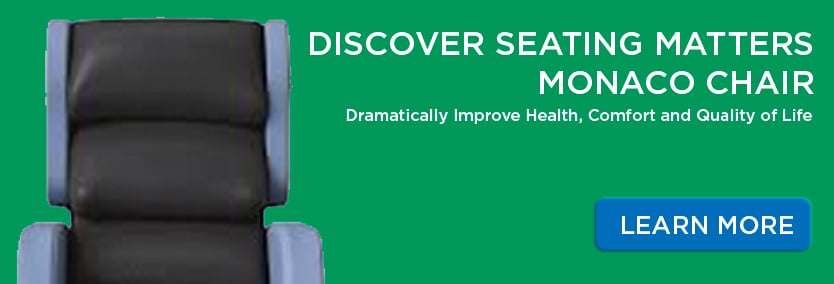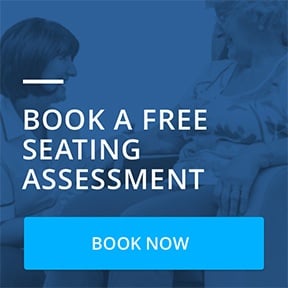Rachel, a 94 year old female, had arthritis in her left knee and a history of falls. She mobilized with a walking frame and needed assistance for all transfers*.
Rachel was a lady who took part in a Seating Matters research trial as part of the Intervention Group, which meant that she was assessed and matched with clinical, therapeutic seating from the Seating Matters range.
CLICK HERE TO VIEW THE MONACO CHAIR
Rachel’s old chair was not made to fit her size and the long seat depth and high seat height were causing her to slide from the chair, resulting in a nearly horizontal resting position for long periods of the day.
Rachel had high pressure underneath small, bony, load bearing areas like her heels, sacrum, shoulders and the back of her head. This was both very uncomfortable, as well as severely limiting her functional ability. With pressure damage to her heels, her mobility was restricted.
The caregiver’s main frustrations were that no matter how well they tried to position Rachel, she would always slide into the posture shown in the image above, ‘bracing’ herself in the chair with this extended position. It then became very hard to assist Rachel to stand, as she could no longer position her feet behind her knees in a ‘ready to stand’ position, or use the armrests for propulsion and support. Upon assessment, it was found that Rachel had no postural difficulties such as fixed hip angles, that might cause her to slide from the chair. Her sliding from the chair was simply due to the over-sized seating, which could not be adjusted to suit her needs.
Once positioned in the chair, Rachel no longer slid into a near-horizontal position and she was able to easily maintain upright posture, as well as bend at her knees and hips. Rachel felt that the chair was very comfortable and her emotional well-being greatly improved because she could now achieve small tasks, such as enjoying a scone and cup of tea easily and without fear of spilling it on herself or choking.
Prior to the provision of the Monaco™ chair, two caregivers were required to assist Rachel into a standing position, but with her improved sitting position in the Monaco™, her posture improved and the number of caregivers required was reduced to one. Also, she no longer needed to brace herself in the chair and her feet were fully loaded.
Since using the Monaco™ chair, which was manufactured and adjusted according to her size, the risk of developing pressure injuries on the bony prominence's, has been significantly reduced as Rachel is now able to spread her body weight over a larger surface area, redistributing pressure.
CLICK HERE TO VIEW THE MONACO CHAIR
*This case study should not be interpreted as a predictor or guarantee of future financial or clinical outcomes with different patients. Clinicians and users must employ correct decision making, undertake proper assessments, education, comply with local regulations and ensure correct use of equipment.





